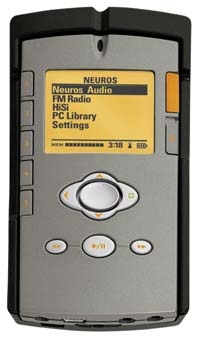The Cutting Edge: Neuros HD MP3 Player Page 2
 While testing the Neuros HD, I soon fell into a routine of recording National Public Radio's All Things Considered in the late afternoon at the office, then listening to it on the way home on the subway, where I can't ordinarily use a radio. I'd also record an hour or two from a classic rock station and listen to it at the health club - fast-forwarding through a 5-minute block of commercials in 25 seconds. The sound was choppy during scanning but good enough to distinguish between yakking and music.
While testing the Neuros HD, I soon fell into a routine of recording National Public Radio's All Things Considered in the late afternoon at the office, then listening to it on the way home on the subway, where I can't ordinarily use a radio. I'd also record an hour or two from a classic rock station and listen to it at the health club - fast-forwarding through a 5-minute block of commercials in 25 seconds. The sound was choppy during scanning but good enough to distinguish between yakking and music.
Though FM-to-MP3 recording in a portable player was introduced last year in several flash-memory models from iRiver, Digital Innovations makes the feature more practical by letting you save programs to a spacious hard drive. And on-the-fly recording is made even more useful by the HiSi feature. Say you happen to tune into a song on the radio that you like but don't recognize. You can't rely on a DJ to provide the information. Click the orange button once anytime during the song to save a 30-second HiSi clip. Next time you sync the Neuros to your Internet-connected computer, all of your HiSi clips are uploaded to the Neurosaudio.com site for identification.
I was skeptical whether a song fragment transmitted in analog form via conventional radio broadcasting, containing neither embedded text nor header information, could be identified as readily as a known criminal's thumbprint. So I tuned in several FM stations and arbitrarily saved a dozen HiSi clips, ranging from "The Twist" (Chubby Checker, 1960) to "Jenny from the Block" (Jennifer Lopez, 2002). Remarkably, the system identified all 12 correctly. Keep in mind, though, that the database is designed to cover the type of music broadcast by 98% of commercial radio stations. It doesn't contain classical music or lesser-known jazz. But with my pedestrian tastes, I was impressed.
Interestingly, Digital Innovations says that by the time you read this, Neuros players will also let you save HiSi clips with music fed through the stereo line or mono mike input. I really could have used the Neuros recently when I lingered under a ceiling speaker in my gym's dressing room hoping to hear the name of an upbeat ditty I still haven't been able to get out of my head. I never did identify it, and, unfortunately, formulating a query by humming into the Neuros mike is not an option.
Another cool feature built into the Neuros player is the ability to broadcast to any nearby FM radio. Called MyFi, the facility is particularly handy in a car, since nothing needs to be plugged in - unless, of course, you want to use the supplied cigarette-lighter adapter for power.
I set up the Neuros HD to broadcast to the stereo receiver in my living room. MyFi automatically scans across the FM band to find an empty frequency. You can also set it manually. The New York City airwaves are crowded, but AutoScan found a relatively quiet frequency on the lower FM band.
I placed the Neuros on a table about 10 feet from my receiver, and my library of MP3 tracks played clearly through my stereo system. The Neuros automatically switches to MyFi when its earphones aren't plugged in. You can switch the broadcast to mono to improve the clarity, but I didn't find that necessary. I did have to turn the volume up higher on my receiver than for a normal FM station, but Digital Innovations says a planned software upgrade should make that unnecessary by the time you read this. (Raising the volume on the player itself affects only the earphones.) I was able to carry the player about 20 feet from my receiver before losing the signal, though I had to be careful not to hold it from its top since that interfered with the signal.
I also broadcast an MP3 track of the Grateful Dead's "Truckin'" to an iRiver flash player with FM recording capability and copied the track without any noticeable loss in fidelity. It's not hard to imagine that once teenagers get their hands on this technology, spreading new music invisibly to groups of friends could go on even in a classroom unbeknownst to teachers or anyone else not clued in on their frequency.
Though I wish Digital Innovations had abided by the tenet that portable electronics are supposed to get smaller, not larger, the Neuros HD offers some gee-whiz features that make me willing to drag along the few extra ounces.
Digital Innovations www.neurosaudio.com, 866-563-8767




























































